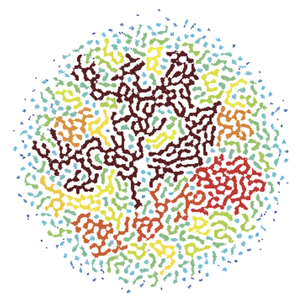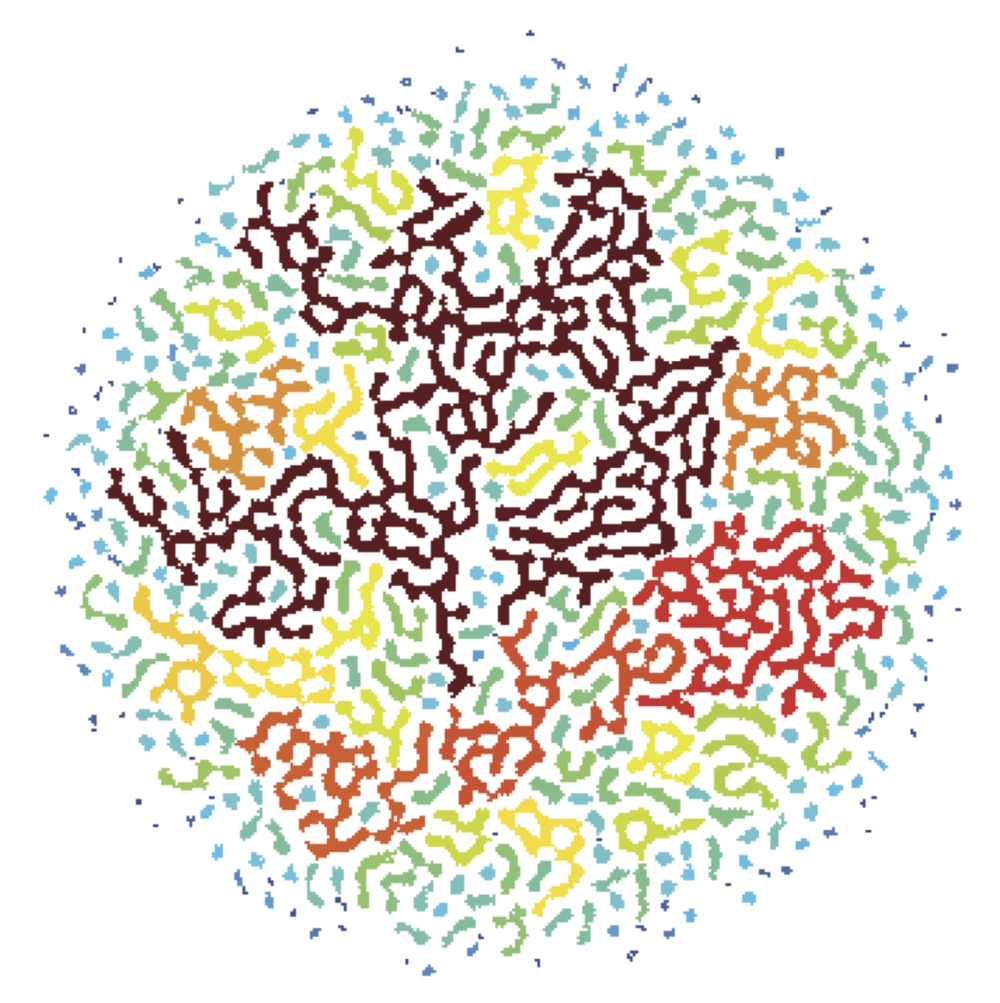Laser Filaments Go through Phase Transition
A high-powered laser beam traveling in air can split up into small “filaments,” rather than remaining as a single unit. A new analysis of laser filamentation shows that the onset of multiple filaments involves a phase transition that is similar to the one that occurs for water percolating through coffee grounds. Understanding this transition could potentially help in controlling laser filamentation, which can interfere with lasers used to channel lightning or to probe the atmosphere.
When high-intensity light interacts with air, it can self-focus into a filament centered around a thin core of plasma. Given enough power, a pulse of this light will start out as a single beam but will then separate into multiple filaments that are unstable, disappearing and reappearing at different locations in the beam cross section as the pulse travels. Understanding how these filaments develop—and how they affect the flow of electricity through the plasma within the filaments—is important for the uses of filaments in lightning control and guiding light waves for telecommunications.
In their study of multiple filamentation, a team led by Jean-Pierre Wolf of the University of Geneva realized that the onset of filamentation (as seen in cross section) resembles percolation of liquid through coffee or other porous materials. The researchers were analyzing data from an earlier experiment in which the filamentation of 100 terawatt laser pulses was recorded using photographic paper [1]. When the paper was placed close to the source, the laser burned a round, uniform patch into the paper. But at a distance of five meters or so, the cross-section began to “curdle,” or fragment into a blotchy pattern permeated by low-intensity voids. Eventually, at larger distances, the burn region separated into elongated, high-intensity islands, or “clusters,” that snaked around one another (see video). These islands mark regions where multiple filaments have developed.
Porous materials can exhibit similar structure. Slice through the material, and you can see voids that look like the “islands” in the laser cross sections. If these voids form an interconnected path, then water can flow across, or “percolate,” from one side to the other. Previous work has shown that if you gradually increase the porosity of a medium, there is a sudden phase transition from nonpercolating to percolating. The two-dimensional version of this transition behavior resembles the diagram of disease spreading through a population or the alignment of a collection of magnetic spins of atoms or electrons.
Using percolation theory as their basis, Wolf and his colleagues analyzed the laser filament data in terms of a two-dimensional lattice. Sites in the lattice were labeled “occupied” if their laser intensity was above a certain threshold. The team showed that the filling factor—the fraction of occupied sites—decreased steadily with propagation distance. They also showed that the “percolation probability” (the probability that occupied sites connect all the way across) drops abruptly from one to zero at a filling factor of 48%, which corresponded to a propagation distance of roughly 11 meters. So a phase transition occurs at this distance.
With the help of computer simulations, the researchers characterized this phase transition mathematically and found similarities with percolation of fluid through a porous material. However, there were some differences between the filaments and percolation behavior, which team member Wahb Ettoumi thinks resulted from filament clusters having a typical size of 2mm2, whereas percolation clusters come in a wide range of sizes.
The analogy to percolation may help researchers developing laser filaments for lightning control or other uses, because the connections among filaments affects the long-range conductivity of the plasma in each filament’s core. But the analogy may also work in the other direction, with filaments providing a new way of studying phase transitions related to percolation. The advantage of laser filaments is that the phase transition can be directly observed, as opposed to magnetic materials, for example, where the percolation-like behavior of the spins occurs at a microscopic level. Ettoumi plans to use laser filaments to study how these types of systems respond to fluctuations.
“The connection of the multiple filamentation to a phase transition is certainly important,” says Daniele Faccio from Heriot-Watt University in the UK. “On the one hand, it provides us with a new system in which to study these kinds of phase transitions and percolation. And on the other hand, it provides a new tool with which to understand, analyze, and hopefully control filamentation.”
–Michael Schirber
Michael Schirber is a Corresponding Editor for Physics Magazine based in Lyon, France.
References
- S. Henin et al., “Saturation of the Filament Density of Ultrashort Intense Laser Pulses in Air,” Appl. Phys. B 100, 77 (2010)





